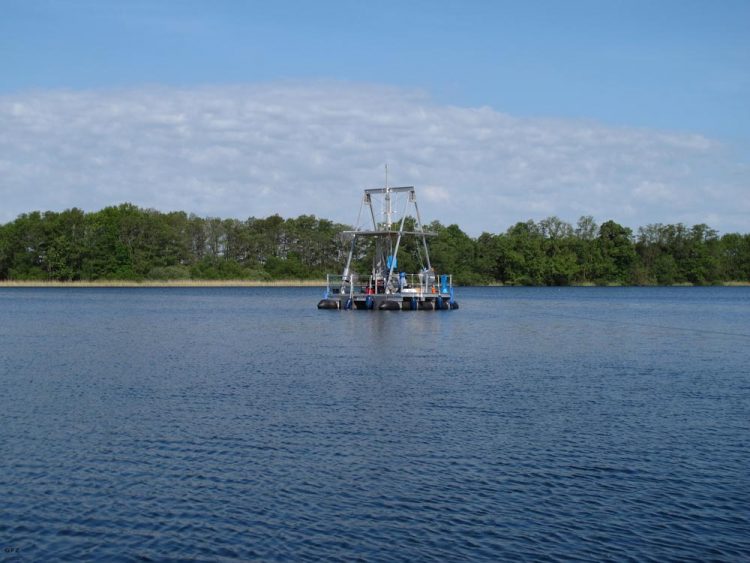Traces of islandic volcanoes in a northeastern German lake

Lake coring on Lake Tiefer See, Mecklenburg-Vorpommern (photo: Stefan Lauterbach, GFZ)
Traces of volcanic ash originating from islandic volcanoes have been found in the sediments of Laker Tiefer See in the Nossentiner-Schwinzer Heide natural park in Mecklenburg-Vorpommern. This allows to more precisely date climate changes of the last 11500 years.
An international team of geoscientists lead by the GFZ German Research Centre for Geosciences detected traces of in total eight volcanic eruptions on Island of which six could be precisely identified. The oldest eruption occurred 11400 years ago and the youngest from AD 1875 has been also described in historical documents.
Seasonally laminated lake sediments represent ideal geoarchives for reconstructing natural climate variability in the past. Achim Brauer from the Research Centre for Geosciences explained the particular importance of the identified volcanic ash deposits:
“Particles of three of the volcanic ashes detected in Lake Tiefer See have been also found 500 km further East in a lake in Poland. For the first time, this allows to synchronize both sediment archives to the year precise, which enables us to decipher even subtle regional differences of climate changes in the past. This information, in turn, provides the chance to better anticipate regional aspects of future climate change.“
The particular challenge of this approach was the fact that volcanic ash was not deposited as visible layers, but only as a few tiny volcanic glass particles scattered in the lake sediments. “These small glass particles commonly are smaller than 50 micrometer“, explained GFZ-scientist Sabine Wulf.
“We applied a novel combination of chemical and microscopic methods to detect these fine traces in the lake sediments and to separate them for further analyses.“ Geochemical analyses of individual glass shards and their comparison with volcanic ash from the source region on Island ideally allows to precisely tracing back the corresponding volcanic eruption.
Moreover, this approach allows reconstructing the distribution of volcanic ash clouds from eruptions in the past over large areas and thus provides new insights into past wind conditions.
This study was carried out within the frame of the Virtual Institute ICLEA (Integrated Climate and Landscape Evolution Analyses, www.iclea.de) funded by the Helmholtz Association and are a contribution to the TERENO observatory for climate and landscape evolution an North-Eastern Germany coordinated by the GFZ.
Sabine Wulf, Nadine Dräger, Florian Ott, Johanna Serb, Oona Appelt, Esther Guðmundsdóttir, Christel van den Bogaard, Michał Słowinski, Mirosław Błaszkiewicz, Achim Brauer: “Holocene tephrostratigraphy of varved sediment records from Lakes Tiefer See (NE Germany) and Czechowskie (N Poland)”, Quaternary Science Reviews 132(2016), January 2016, DOI: http://dx.doi.org/10.1016/j.quascirev.2015.11.007
Media Contact
More Information:
http://www.gfz-potsdam.de/All latest news from the category: Earth Sciences
Earth Sciences (also referred to as Geosciences), which deals with basic issues surrounding our planet, plays a vital role in the area of energy and raw materials supply.
Earth Sciences comprises subjects such as geology, geography, geological informatics, paleontology, mineralogy, petrography, crystallography, geophysics, geodesy, glaciology, cartography, photogrammetry, meteorology and seismology, early-warning systems, earthquake research and polar research.
Newest articles

A universal framework for spatial biology
SpatialData is a freely accessible tool to unify and integrate data from different omics technologies accounting for spatial information, which can provide holistic insights into health and disease. Biological processes…

How complex biological processes arise
A $20 million grant from the U.S. National Science Foundation (NSF) will support the establishment and operation of the National Synthesis Center for Emergence in the Molecular and Cellular Sciences (NCEMS) at…

Airborne single-photon lidar system achieves high-resolution 3D imaging
Compact, low-power system opens doors for photon-efficient drone and satellite-based environmental monitoring and mapping. Researchers have developed a compact and lightweight single-photon airborne lidar system that can acquire high-resolution 3D…





















